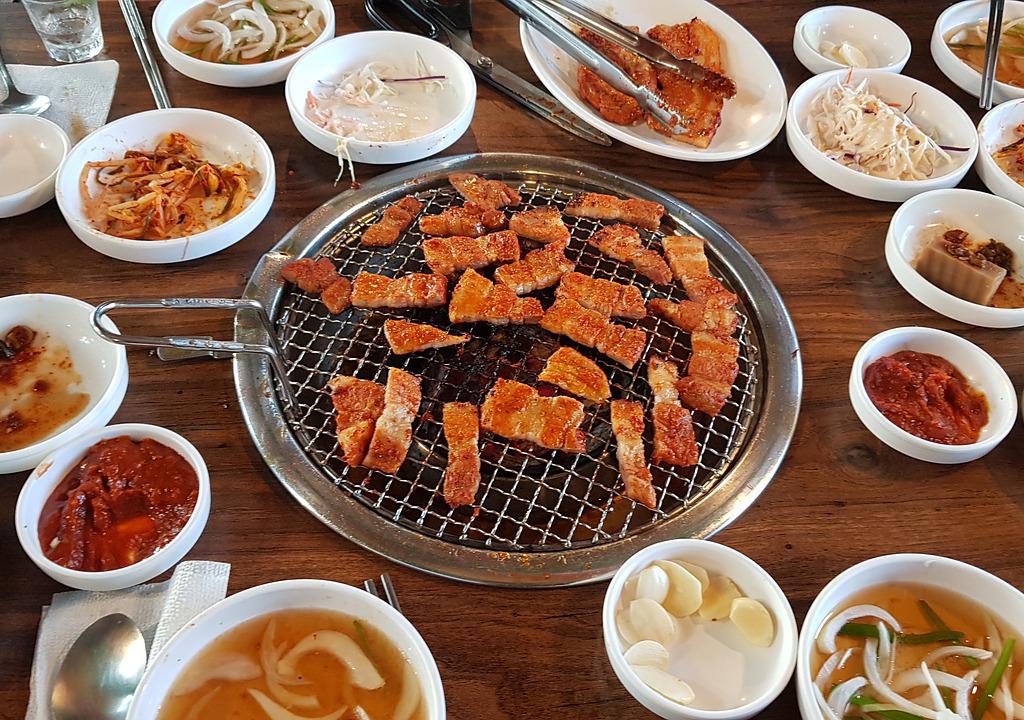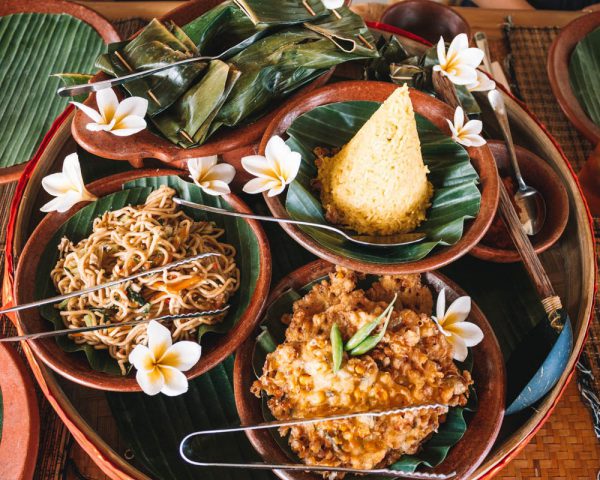Last Updated on April 13, 2023
Korean barbecue restaurants are popping up like mushrooms all around Western countries but are they worth the hype?
The short answer is yes, Korean barbecue is superbly delicious and versatile. It’s a great food option when looking for a fun and tasty way to entertain some guests and try something new and exciting yourself.
Now let’s take a deep dive into this new trend. We lay a wager you’ll be googling the closest Korean barbecue place by the time you finish this article.
The Korean Way of Grilling Meat
Some would say all you need for a good barbecue is the right heat and meat. Even though simplicity is the key to success in some situations, Korean BBQ offers a bit more. The zesty contrast and harmony between different flavors and textures are essential to this dining experience.
One of the most important things that make Korean BBQ so unique is the way the meat is prepared. High-quality beef, pork, or chicken is first cut into small, tender pieces. You can marinate the meat using a variety of sauces to give the dish a unique flavor or simply slice it into bite-sized fatty chunks.
The usual menu for the marinated meat includes short steak (jumulleok), beef short ribs (galbi or kalbi), sirloin, ribeye, or brisket beef strips (bulgogi), thin-cut rib meat (kalbisal), and finger short ribs (nook gan sal).
If you prefer non-marinated meat, you can have chimasal (flank steak), thinly sliced brisket (chadolbaegi), sirloin steak (deungsim), thinly sliced beef belly (samgyup), beef tenderloin (andeungsi), beef tongue (hyuh mit gui), pork belly (samgyeopsal), or pork chop (moksal), along with chicken varieties — but you can also have a pescatarian or vegetarian Korean BBQ experience.
Depending on where you are, you can also find special meats in your region. For example, you’ll find Kobe beef from California in a Korean BBQ restaurant in the US.
The pieces of meat are cooked over an open flame, adding a smoky flavor to the tender pieces of meat, like a regular barbecue. The twist is that you have the cooking station on the table, and you get served the meat right off the hot skillet or grill and directly on your plate.
What are Korean BBQ Side Dishes aka Banchans?
The juicy, high-quality meat sizzling in front of you is already tantalizing. But what makes Korean barbecue a stroke of genius is the side dishes that accompany the meat. Koreans love these little munchies called banchan and consider them a great way to work up your appetite, which we certainly agree with — there’s nothing better than following a bite of meat with a bite of kimchi.
When you sit down at a Korean barbecue place, your table will be covered with small plates of banchan, sauces, and dips ahead of the main course. Banchan includes pickled vegetables, fermented soybean pastes, noodles, rice, and soups that turn the grill into a complete meal. The combination of these various sauces and the delicious grill make up for a unique experience.
There might be over 250 varieties of banchan in Korean cuisine, roughly categorized as fresh vegetable banchan like namul and muchim, braised and soy sauce-induced banchan called jorim, and fermented banchan like jeotgal and kimchi. Here are some of the most popular appetizers you can have at a Korean BBQ restaurant:
- Yangpa Jangajji: Pickled onions.
- Danmuji: Sweet and sour pickled radish.
- Ssamjang: A dipping sauce made of Korean soybean paste, chili paste, and other aromatics like honey, garlic, sesame oil, or sugar.
- Kongnamul Muchim: Soybean sprouts seasoned with soy sauce, sesame oil, garlic, and scallions.
- Gamja Saelleodeu: A smooth, sweet, and creamy potato salad with small chunks of carrot, broccoli, apple, peas, and other fruits and vegetables.
- Various Seaweeds: Kelp, wakame, laver, and other underwater plants sprinkled with various seasonings.
- Gyeran / Maechurial Jorim: Eggs boiled in soy sauce, usually served along vegetable grills, rather than meat barbecues.
- Sigeumchi Namul: Seasoned steamed spinach.
- Kkakduhi: A variation of kimchi made of cubed radishes and chili pepper grounds. It’s a sweet and spicy dish usually served with hearty stews.
- Saewoo / Myulchi Bokkeum: Tiny crunchy dried anchovies or shrimps, stir-fried in a sweet soy syrup.
- Beachu Kimchee: Tangy fermented cabbage with spices and red pepper paste.
- Eomuk bokkem: Stir-fried fish cakes glazed with a sweet and savory sauce.
- Gamja Jorim / Goguma Mattang: Braised sweet potatoes glazed with a thick sauce made of soy sauce, garlic, corn syrup, and sesame seeds.
Korean BBQ is a Social Dining Experience: The More, the Merrier!
Korean BBQ is the perfect meal for any social occasion because when you’re a big party, everyone can decide what to eat from the various dishes on the table, and you get to try more options, thanks to the generous portions.
When the table is filled with small dishes of banchan, everybody customizes their bite-sized leafy wraps. You can get a piece of lettuce of perilla leaf, put some rice or kongnamul muchim in it, add a piece of sizzling, soft, and buttery meat from the barbeque, and top it with any other fresh or tangy banchan on the table. The combinations are endless!
Tips for First Timers at Korean Barbecue
Here are some tips to make the best of your trip to a Korean BBQ restaurant.
Ordering
Even though you can have a pescatarian, vegetarian, or even a vegan feast at a Korean BBQ place, the most popular option remains beef or pork. You can order marinated or plain meat, or if you’re feeling adventurous, you can go for more extravagant options like cattle tongue (cyutan) or chicken gizzards.
As a first-timer, you probably don’t have a favorite, so it might be best to try plain meat first before moving on to the more complex flavors. Once you feel comfortable with the basics, you can move on to the marinated sweet, sour, and tangy meat bites. And if you’re still curious, you can go full-on Korean and order some gopchang, a meat dish made from small cattle intestines — or makchang (pig intestines), the abomasum of cow, or some pork skin.
Who Does the Cooking?
At some Korean BBQ places, you can have your meat cooked and served to you and at others, you cook it yourself. If you choose the second option, you get an even cozier feel at the table, just like dining at home. Just remember that the small pieces of meat cook pretty fast and don’t be afraid to throw some kimchi, mushrooms, and garlic on the grill.
If the sheer amount of meat types intimidates you, don’t panic. The restaurant staff is there to take over the cooking — they also make sure to put on a show while doing it. And they are professionals, remember? So don’t worry about anything burning or overcooking. Just sit back and relax.
Take Things Slow
It’s wise to go to a Korean BBQ place on an empty stomach. But once the delectable smells start rising from the grill, it might be hard to stop your urge to gulp up the delicious banchan on the table.
When that happens, remember the marshmallow test – that kid who patiently waited before knocking off that marshmallow is a CEO now. Well, maybe not, but if you devour everything on the table before the main course is ready, you’ll miss the whole point of combining banchan with sizzling meat. Banchan is more of a side dish than a starter.
The Art of Preparing a Flavor Bundle: Ssam
On your first couple of tries, you can dip the plain meat into various sauces and banchan to taste an extra layer of flavor. Give soy sauce, sesame oil, chili, or other tastes on the table a try.
Once you familiarize yourself with the flavors and the meat bites, try making ssam, a sort of wrap where you combine the different flavors across the table with your meat in your hand. To do that, take a green leaf and run your imagination wild, filling it with different types of banchan and sauces.
What to Drink at a Korean BBQ
In Korea, it’s customary to wash the delicious ssams down with booze. You can always go with your favorite kind of wine, but if you’d like to try some traditional Korean beverages, order soju, (distilled Korean booze made of rice), Korean beer, or somaek, a combination of the two.
Relish Today, Ketchup Tomorrow!
If you go to an “all you can eat” Korean BBQ, there will probably be a policy on leftovers, meaning you can’t take them home with you, and you need to pay for the uncooked and uneaten things on your table — so think twice before you order an extra plate of banchan!
But if that’s not the case, Korean barbecue is one of the easiest leftovers to repurpose the next day. You can make terrific rice bowls with meats and pickled veggies. You can mix various banchan with fresh vegetables to make a rockstar salad or simply throw them on avocado toast for an easy breakfast.
Can You Make Korean Barbecue at Home?
Making the whole thing at home can be time-consuming and tiring, but at the end of the day, the communal dining experience with your friends and family, with shared dishes, stories, and drinks, is worth the trouble. As long as you have the proper equipment and well-ventilated space, you can make Korean barbecue from the comfort of your home.
An indoor grill is the first thing you need to recreate this unique experience at home. Once you sort that out, move on to picking your meats. You’re free to use any kind of meat, but if you’re looking for some hints to make it count, we suggest chadol baegi (brisket), bulgogi (marinated and thinly sliced beef or pork), galbi (short ribs), or sagyeopsal (pork belly). You can find these in a Korean grocery store or even at Walmart. Cut them into proper sizes and marinade the pieces in your favorite marinade.
There are several options for the green leaves to make traditional ssams: lettuce, sisho, rice paper, or even pickled daikon radish slices.
And for the banchan, you always have the option to prepare them yourself. But if it all turns into a daunting task, you can hit the Korean store for some ready-made banchan.
Over and Out!
Korean barbecue is a new trend taking over the western world, and we think it deserves all the attention it gets. It’s different from your regular eat-outs, as it turns the food into a communal activity from start to finish. Korean BBQ is a fantastic way to eat grilled meat, combining the smokey tender bites with all the different flavors in Korean cuisine, from funky fermented kimchi and soybean pastes to fresh minty salads.
Korean barbecue is worth checking out if you’re looking for a new culinary experience. Whether you dine at a restaurant or cook it at home, this cuisine will surely please your taste buds and satisfy your craving for sizzling meat.
















